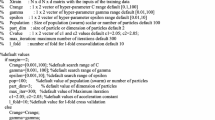Abstract
A candidate set of support vectors is selected by using pulse-coupled neural networks to reduce computational cost in learning phase for support vector machines (SVMs). The size of the candidate set of support vectors selected this way is smaller than that of the original training samples so that the computation complexity in learning process for support vectors machines based on this candidate set is reduced and the learning process is accelerated. On the other hand, the candidate set of support vectors includes almost all support vectors, and the performance of the SVM based on this candidate set matches the performance when the full training samples are used.



















Similar content being viewed by others
References
Boser B, Guyon I, Vapnik V (1992) A training algorithm for optimal margin classifers. In: Proceedings of the fifth annual workshop on computational learning theory. ACM Press, Pittsburgh, PA
Burges C (1996) Simplified support vector decision rules. In: Sartta L (ed) 13th international conference on machine learning. Morgan Kaufmann, San Mateo, CA
Caufield HJ, Kinser JM (1999) Finding shortest path in the shorest time using PCNN’s. IEEE Trans Neural Netw 10(3):604–606
Chang CC, Lin CJ (2001) LIBSVM: a library for support vector machines. http://www.csie.ntu.edu.tw/~cjlin/libsvm
Eckhorn R, Reitboeck HJ, Arndt M, Dicke PW (1990) Feature linking via synchronization among distributed assemblies: simulation of results from cat cortex. Neural Comput 2(3):293–307
Gu X, Yu D, Zhang L (2004) Image thinning using pulse coupled neural network. Pattern Recognit Lett 25(9):1075–1084
Gu X, Yu D, Zhang L (2005) Image shadow removal using pulse coupled neural network. IEEE Trans Neural Netw 16(3):692–698
Johnson JL, Padgett ML (1999) PCNN model and applications. IEEE Trans Neural Netw 10(3):480–498
Kuntimad G, Ranganath HS (1999) Perfect image segmentation using pulse coupled neural networks. IEEE Trans Neural Netw 10(3):591–598
Lee YJ, Mangasarian OL (2001) RSVM: reduced support vector machines. In: Proceeding of the 1th SIAM international conference, Data Mining
Lee YJ, Mangasarian OL (2003) A study on reduced support vector machines. IEEE Trans Neural Netw 14(6):1449–1459
Lv JC, Yi Z, Tan KK (2007) Determining of the number of principal directions in a biologically plausible PCA model. IEEE Trans Neural Netw 18(3):910–916
Osuna E, Girosi F (1998) Reducing the run-time complexity of support vector machines. In: International conference on pattern recognition. IEEE, Brisbane
Platt JC (1998) Sequential minimal optimization: a fast algorithm for training support vector machines. Technical Report MSR-TR-98-14, Microsoft Research
Peng DZ, Yi Z, Lv JC (2008) A stable MCA learning algorithm. Comput Math Appl 56(4):847–860
Qu H, Yang SX, Willms AR, Yi Z (2009) Real-time robot path planning based on a modified pulse-coupled neural network model. IEEE Trans Neural Netw 20(11):1724–1739
Shang LF, Lv JC, Yi Z (2006) Rigid medical image registration using PCA neural networks. Neurocomputing 69(16–18):1717–1722
Thies T, Weber F (2004) Optimal reduced-set vectors for support vector machines with a quadratic kernel. Neural Comput 16:1769–1777
Tipping M (2001) Sparse Bayesian learning and the relevance vector machine. J Mach Learn Res 1:211–244
Vapnik VN (1995) The nature of statistical learning theory. 2nd edn. Springer, New York
Vapnik VN (1998) Statistical learning theory. Wiley, New York
Yang S, Ye M (2012) Multistability of α-divergence based NMF algorithms. Comput Math Appl 64(2):73–88
Acknowledgments
This work was supported by Specialized Research Fund for the Doctoral Program of Higher Education under Grant 2010081110053 and National Program on Key Basic Research Project (973 Program) under Grant 2011CB302201, partially supported by National Science Foundation of China under Grant 61375065.
Author information
Authors and Affiliations
Corresponding author
Rights and permissions
About this article
Cite this article
Li, Y., Yi, Z. & Lv, J.C. Support vector set selection using pulse-coupled neural networks. Neural Comput & Applic 25, 401–410 (2014). https://doi.org/10.1007/s00521-013-1506-8
Received:
Accepted:
Published:
Issue Date:
DOI: https://doi.org/10.1007/s00521-013-1506-8




